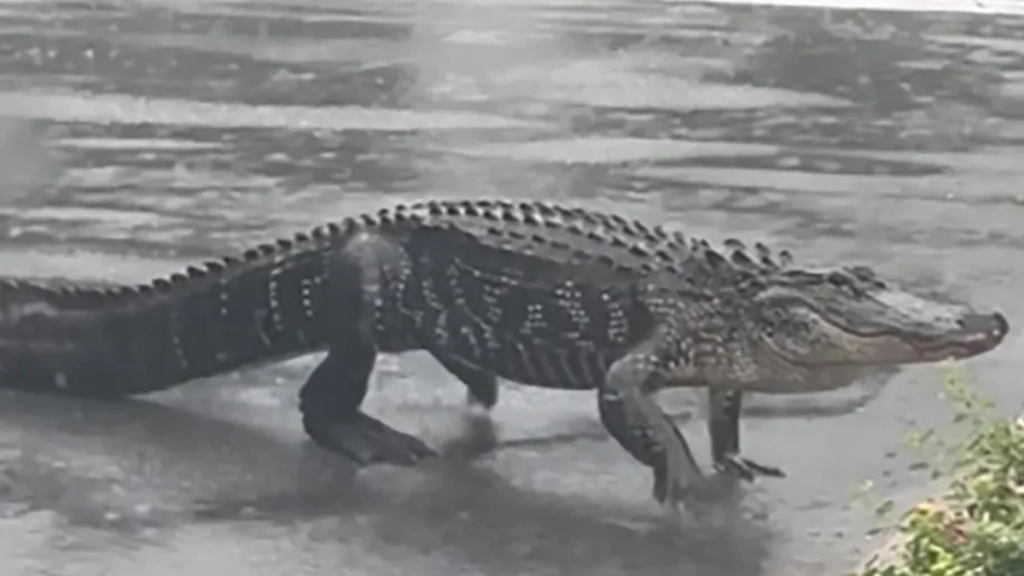As temperatures begin to soar across South Carolina, wildlife officials are issuing strong warnings to residents: Alligators are on the move. The seasonal shift has brought the reptiles out of their usual hiding spots, and sightings in residential areas are on the rise.
With the Palmetto State experiencing its first heat wave of the year, encounters with these prehistoric predators could become more frequent—and more dangerous.
Officials with the South Carolina Department of Natural Resources (SCDNR) say the rise in temperature encourages alligator activity, particularly in low-lying areas close to lakes, rivers, marshes, and even backyards. As the reptiles become more active, they’re searching for food, mates, and new territory.
“Alligators are cold-blooded creatures, and their activity is directly tied to the heat,” said David Lucas, spokesperson for the SCDNR. “When temperatures go up, so do sightings.”
Where Alligators Are Being Spotted
From Charleston to Myrtle Beach and even into inland suburbs, reports of alligators showing up in yards, golf courses, and residential streets have become more common. Several viral videos circulating online show gators crossing busy roads or lounging in neighborhood driveways.
Local authorities in places like Mount Pleasant and Bluffton say they’ve responded to multiple calls in recent weeks involving gators in unexpected places. In some cases, the reptiles were simply passing through. In others, they needed to be removed by wildlife control professionals for the safety of both humans and the animal.
“This is their home, too,” said Lucas. “But when their habitats shrink due to development or weather changes, they’re forced to navigate new areas, including where people live.”
Why Now?
Alligators typically become more active in the spring and summer as their body temperatures rise. During winter months, they enter a period of dormancy called brumation, staying mostly still in burrows or at the bottoms of ponds.
But once it warms up—especially with temperatures hitting the 80s and 90s—they emerge to bask in the sun and start hunting.
Their breeding season, which begins in late April and peaks in May and June, is another reason for the uptick in movement. Male alligators are known to travel long distances to find a mate, and that may include crossing into residential zones or public spaces.
According to the SCDNR, the increase in sightings isn’t necessarily cause for alarm, but it is a reminder that residents need to stay alert. “These animals are not typically aggressive, but they can be if they feel threatened or are protecting a nest,” said Lucas.

How to Stay Safe Around Gators
Authorities stress that while gator sightings may be exciting—or even amusing—they are not opportunities for selfies or up-close videos. Residents are encouraged to keep their distance and follow these safety guidelines:
- Never feed alligators. It’s illegal in South Carolina and causes gators to lose their fear of humans.
- Keep pets and small children away from water edges, especially in the early morning or evening hours when gators are most active.
- Be cautious around fresh and brackish bodies of water, especially if you see warning signs.
- Do not attempt to capture or move an alligator yourself. Call local authorities or SCDNR.
Gators Are a Vital Part of the Ecosystem
Though they may seem like a nuisance when wandering into neighborhoods, alligators play an important ecological role in South Carolina’s wetlands. They help control populations of prey species, like turtles and fish, and create “gator holes” that retain water for other wildlife during dry spells.
South Carolina is home to an estimated 100,000 alligators, most of which live peacefully within the state’s extensive swamp systems and coastal marshes. Gator-human interactions remain relatively rare but can become more frequent in times of heat or drought.
Residents React with Caution and Curiosity
For many South Carolinians, living near gators is just part of life. “I’ve seen them crossing the road more this month than I did all of last year,” said Michelle Owens, a Charleston resident. “It’s scary but also kind of fascinating.”
Others are more cautious. “I don’t let my dog out without checking the yard anymore,” said Bill Tucker, who lives near a pond in Hilton Head. “They’re out there, and we have to respect that.”
Wildlife officials echoed that sentiment, urging residents to remain respectful of nature’s boundaries—even when they blur. “These creatures have been here for millions of years,” said Lucas. “We’re just the latest neighbors.”
Final Thoughts
With warmer days ahead, alligator activity in South Carolina will only increase. Residents are advised to stay informed, respect wildlife boundaries, and avoid risky behavior. As communities grow and the environment continues to shift, coexisting with native species like the alligator will require awareness, caution, and mutual respect.
While the sight of a six-foot reptile on a sidewalk may be startling, it’s also a reminder of South Carolina’s unique and wild beauty—one that deserves to be understood and protected.
For official safety tips and updates, visit the South Carolina Department of Natural Resources.
Disclaimer – Our team has carefully fact-checked this article to make sure it’s accurate and free from any misinformation. We’re dedicated to keeping our content honest and reliable for our readers.
